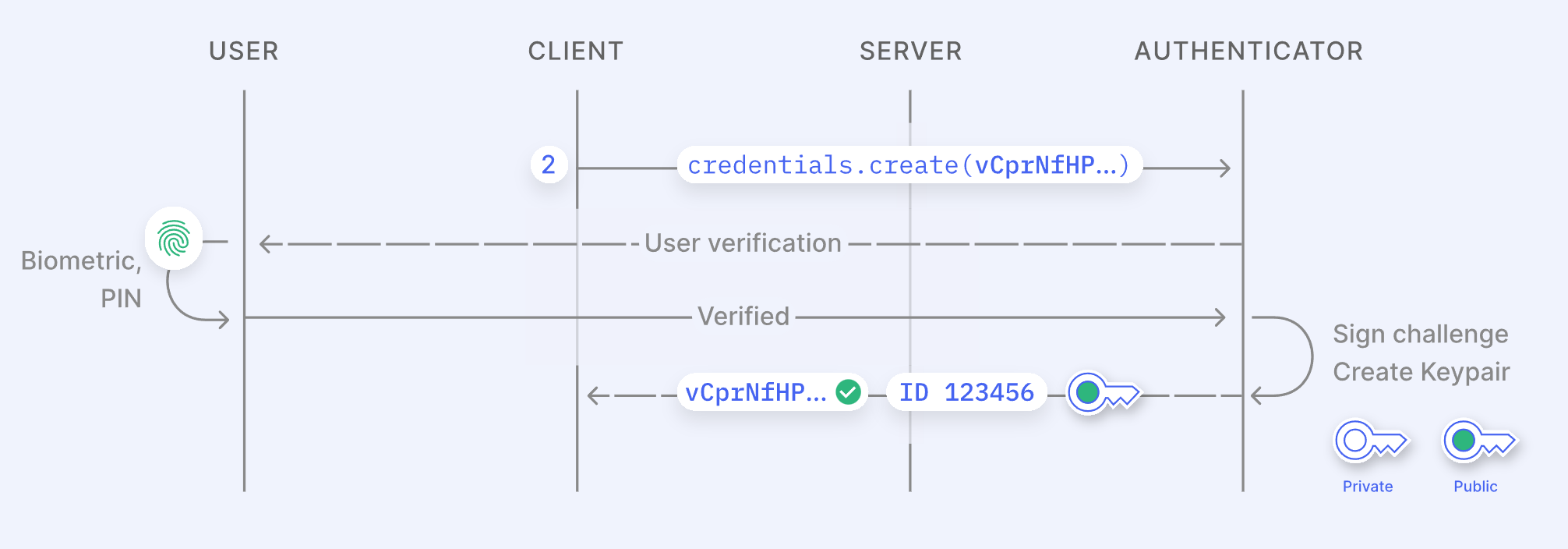We've all been there. You try to log into your bank account with your username and sex video pretty girlpassword only to be met with a generic "incorrect password" error. You double-check your password manager, try a few variations, but after too many failed attempts, the system locks you out. Now you're funneled into a tedious re-authentication process involving security questions you barely remember and a password reset form that smugly informs you, "New password can't be the same as the old one." You proceed to throw your device in frustration.
A passkey is a secure, easy-to-use replacement for passwords. It uses your device's built-in security (like Face ID, fingerprint, or a PIN) to log you into a website or service, without requiring you to remember or type anything.
The passkey is then stored on a secure element of your phone or computer, which means the website or service you're accessing won't need to store any passwords on their servers – reducing the risk of breaches or hacks.
In practical terms, you could say passkeys merge the concept of a password and 2FA (two-factor authentication) into one smooth action, but way more secure and way less annoying.

As an optional and recommended step, you can store your passkeys inside a secure password manager such as Proton Pass, 1Password, Dashlane, or Bitwarden. This allows you to sync and access your passkeys across multiple devices.
Creating a passkey is easy, and the process is similar across most platforms. To illustrate, here's how we set up a passkey for Amazon.com and used a password manager to store it...
First, I log into my Amazon account and navigate to the Login & Security section to access the passkey option.

Next, I click on "Add a passkey," which creates a passkey specifically for Amazon. As shown in the screenshot, I had previously created a passkey that's stored in my iCloud Keychain. You can create multiple passkeys for the same website and store them in different places.

Because I use Proton Pass and I have their browser extension installed, adding a passkey automatically opens Proton Pass to generate and store it. If I didn't have Proton Pass installed, my web browser (Chrome, Firefox, etc.) would have stored the passkey instead.

Proton Pass will now save this specific passkey for Amazon, synced to my username. Since this is for Amazon, it also works for Amazon Web Services (AWS) accounts.
According to NordPass's research, the most popular password remains "123456" as of 2023 and 2024. The second most popular? "123456789." Other common passwords are usually strings of sequential numbers or variations on "qwerty." After six years of the same study, NordPass concludes that most people's password habits haven't meaningfully changed.
| Feature | Password + 2FA | Passkey |
|---|---|---|
| Steps | Multiple | Single |
| User needs to... | Type & wait | Just confirm |
| Security | Good | Better (phishing-resistant) |
| Convenience | Medium | High |
Passkeys are more secure because they eliminate password-based vulnerabilities, replacing passwords with cryptographic keys that protect users from phishing attacks, credential theft, and data breaches. Passkeys are protected by a single biometric factor, like your fingerprint or face, and no passwords are sent over the internet or stored on external servers.
While not every service has implemented passkey authentication, most popular sites have. Some of the major ones that support it include Amazon, Google, Apple, Github, Adobe, Uber, Microsoft, Nintendo, PlayStation Network, eBay, and Dropbox, as well as many social networks.
Financial institutions (banks) lag behind big tech giants in adopting passkeys, however companies like PayPal, Revolut and Robinhood already support it. Dashlane offers a helpful, community-driven directory of websites that have implemented passkeys login functionality.

You can already create passkeys using Google, Microsoft, or Apple devices. Many password managers – such as Proton Pass, Dashlane, 1Password, Bitwarden, and LastPass – also support passkey creation. As mentioned earlier, using a password manager allows passkeys to sync across devices.
It's also important to remember that passkeys are unique to each website. The passkey you use to sign into your Google account is not the same as the one used for Amazon. That said, a helpful pro tip is to create a passkey for your Google account and then use Google's authentication to sign in to other services (if the option exists). That way you can just use your one Google passkey while being able to access multiple websites.
Passkeys (technically known as Web Authentication or WebAuthn) are a technology that allows credentials to be authenticated without being stored on servers. They are part of the FIDO2 project, which aims to permanently replace passwords as a method of authentication.
The core concept relies on public key infrastructure (PKI). Instead of storing a username and password, passkeys are generated on an authenticator controlled by the user.
This authenticator could be your smartphone (Face ID, fingerprint), your operating system (e.g., Windows Hello), your browser, or a physical security key such as a YubiKey or Google's Titan Key.
Creating a passkey is a 3-step process:



If you lose your device, your passkeys aren't lost – they're securely backed up in the cloud through services like Apple's iCloud or Google's Password Manager (or the password manager of your choice). These backups are end-to-end encrypted, meaning only you can access them, and they sync across your devices for easy recovery.
When you set up a new device, you can restore your passkeys simply by signing in to your cloud account. If you don't have another device, recovery options like a recovery key or multi-factor authentication can help you regain access.
Passkeys also require biometric authentication (like Face ID or a fingerprint) to use. Even if someone steals your phone, they can't access your passkeys without your biometric data.
Password managers are a good step up from remembering passwords, but they still rely on storing credentials on a server. Even open-source options like KeePass require a database of passwords. Even open-source tools like KeePass require you to maintain a password database.
Passkeys offer a more secure and streamlined approach by eliminating the need to manage individual logins. For the best of both worlds, we recommend using password managers alongside passkeys to ensure your credentials stay synced, backed up, and secure.
Absolutely. Phishing typically aims to steal usernames, passwords, or sensitive data. Passkeys don't transmit credentials, making them useless to an attacker even if intercepted.
At most, an attacker might gain access to the public keys stored in the database. Since these can't be used to reverse-engineer your private key, your account remains secure. If needed, you can simply revoke the old passkey and generate a new one.
The purpose of passkeys is to provide personal, identity-bound authentication – not shared credentials. But technically, yes, there are ways to share passkeys.
For example, Apple allows passkeys to be shared via AirDrop under certain conditions. You can also share passkeys by logging into the same password manager.
Yes. While passkeys offer a more secure and user-friendly alternative to traditional passwords, they aren't necessary – or even ideal – in every scenario. Here are a few examples:
Shared accounts
Passkeys are tied to you and your device. So for accounts shared among multiple people (like a shared Netflix account or business login), traditional passwords still work more flexibly – for now.
Enterprise or legacy systems
Older corporate systems, VPNs, or internal tools may not support passkeys at all – some industries move slowly when it comes to adopting new authentication tech.
Non-person entities (NPEs)
Developers using automated systems or scripts, they may need to authenticate to a server to perform tasks like scanning or data processing. In such cases, passkeys aren't practical. This could also extend to software needing to use authentication for secure API calls.
Additionally, there are environments where passkey adoption just doesn't fit yet. If you're on a device that lacks cloud backup or passkey syncing, such as an older smartphone or a public computer, it can be difficult or impossible to use passkeys effectively.
So while passkeys are the future of authentication, there are still valid reasons to stick with passwords in certain contexts – for now.
 Best MacBook deal: Save $200 on 2024 M3 MacBook Air
Best MacBook deal: Save $200 on 2024 M3 MacBook Air
 The Brain? Still Full of Mystery, After All These Millennia
The Brain? Still Full of Mystery, After All These Millennia
 Staff Picks: Renee Gladman, Carol Rama, and Ocean Mythology
Staff Picks: Renee Gladman, Carol Rama, and Ocean Mythology
 Help! My Friend Is a Vaper: Advice from ‘The Paris Review’
Help! My Friend Is a Vaper: Advice from ‘The Paris Review’
 Best Apple Pencil Pro deal: Save $30 at Best Buy
Best Apple Pencil Pro deal: Save $30 at Best Buy
 best audiobook eva?: Lorin Stein Answers Your Questions
best audiobook eva?: Lorin Stein Answers Your Questions
 On the Shelf: the Final Edition
On the Shelf: the Final Edition
 Eight Views of Paradise Interrupted: Paintings by Jennifer Wen Ma
Eight Views of Paradise Interrupted: Paintings by Jennifer Wen Ma
 Nickelodeon announced 'Tiny Chef' was cancelled. The internet can't handle it.
Nickelodeon announced 'Tiny Chef' was cancelled. The internet can't handle it.
 A Letter from Sam Shepard to Johnny Dark
A Letter from Sam Shepard to Johnny Dark
 Daily Cartoon: 1880, Braille
Daily Cartoon: 1880, Braille
 Once I Had This Dream: Gretchen Scherer’s Crumbling Chateaux
Once I Had This Dream: Gretchen Scherer’s Crumbling Chateaux
 “The Ecstatic, The Hermetic, and the Strange”
“The Ecstatic, The Hermetic, and the Strange”
 Poland vs. Georgia 2025 livestream: Watch U21 Euro 2025 for free
Poland vs. Georgia 2025 livestream: Watch U21 Euro 2025 for free
 Staff Picks: Vladimir Mayakovsky, Thom Jones, E.L. Doctorow
Staff Picks: Vladimir Mayakovsky, Thom Jones, E.L. Doctorow
 Daily Cartoon: 1880, Braille
Daily Cartoon: 1880, Braille
 Houston Rockets vs. Dallas Mavericks 2025 livestream: Watch NBA online
Houston Rockets vs. Dallas Mavericks 2025 livestream: Watch NBA online
 The Joys and Frustrations of the Clay Court
The Joys and Frustrations of the Clay Court
Cats on Instagram wish you a meowy Christmas and a happy mew yearBlack Lives Matter website hit with more than 100 DDoS attacks this yearRob Kardashian shares the messy details of his breakup with Blac ChynaThis heartwarming Christmas ad will have you reaching for the tissuesSamsung asks QLED TV owners to run a virus scanPinterest misses, then lowers goal for female tech hiresHighly venomous snake makes like tinsel and chills on a Christmas tree'Big Little Lies' episode 2 recap: It's ironically about telling the truthThis heartwarming Christmas ad will have you reaching for the tissues'Big Little Lies' episode 2 recap: It's ironically about telling the truthLittle girl sends BBC anxious letter about Big Ben, gets the perfect replyHow 'Animal Crossing: New Horizons' will bring out the best of the franchiseNASA spots a telltale 'Star Trek' sign on MarsMarvel drops comic book covers inspired by Jay Z and Kanye WestSpotify's new 'Your Daily Drive' playlist is like FM radioOh happy day, Lizzo channels 'Sister Act 2' performing at MTV AwardsWoman rescues her attacked pup with a tip she learned on RedditBlack Lives Matter website hit with more than 100 DDoS attacks this yearHuawei starts showing ads on smartphone lock screensThis remarkable Greenland photo highlights extreme Arctic melting Magically Master Your Mouse Movement Enhance and Upscale: FSR 2.2 vs DLSS 2.4 Analysis Going Ergonomic: How to Make Your Computing Life Better Best TV deal: Save 29% on the 65 Call of Duty: Warzone 2.0 CPU and GPU Benchmark Monterrey vs. Inter Milan 2025 livestream: Watch Club World Cup for free VidCon 2025 to induct its first creator Hall of Fame class A Chat With Video Game Composer Christopher Tin Explainer: What is SSD Trimming? Amazon is offering 6 new free games before Prime Day for subscribers Meta’s Llama has memorized huge portions of Harry Potter Fluminense vs. Borussia Dortmund 2025 livestream: Watch Club World Cup for free Will GPUs Ever Get Cheaper? GPU Pricing Update Best MacBook deal: Save $150 on 2025 Apple MacBook Air Why Upgrading a Gaming PC Right Now is Almost Pointless How Hot is Too Hot for PC Hardware? GPU Pricing Update: Was AMD's Radeon RX 7000 Launch a Success? Meta and Oakley's smart glasses are coming this week Canada vs. Honduras 2025 livestream: Watch Concacaf Gold Cup for free NYT Connections Sports Edition hints and answers for June 18: Tips to solve Connections #268
2.1699s , 10591.7890625 kb
Copyright © 2025 Powered by 【sex video pretty girl】,Wisdom Convergence Information Network